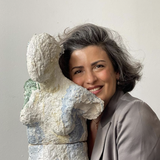This pop-up exhibition, which will be held on the 21st of February at New Metropolis Nieuw-West, is the result of a series of clay workshops hosted by Esra Sakir called: Mud Break. Esra is a visual artist and in crafting her artistic narrative, she reflects on the profound connection between humanity and the environment, and the urgency to redefine our relationship with existence in the face of the challenges posed by the Anthropocene. Throughout the workshops, clay material was transformed into various shapes, fostering a dialogue between the artist and the participants. This evening is an opportunity for us to collectively appreciate all the work produced during the workshops, share smiles, and exchange our experiences. It’s also the moment for participants to retrieve their pieces after they’ve undergone bisque firing and glazing.


More about the project
In these workshops we focused on our historical human-nature relation, iconographical inspirations by matriarchal traditions and female divine representations of Mesopotamia and Asia Minor as Kubaba, Cybele, Ishtar and Artemis of Ephesus.
The series of workshops where designed to reconnect with the earth, experience one’s creativity and consciously recognise one’s origins and (re)discover the technique of modeling clay. The art of ceramics is one of the oldest and most primitive human activities. Its processing is very profound, liberating, and offers immediate activation. This is because the manipulation of the clay allows – due to its elasticity and plasticity – not only the learning of techniques, but also to regain one’s own bodily perception. To enter in more profound contact with our manual skills and to reclaim a capacity that is inherent in human nature and is functional to the processing of personal experiences. You cannot manipulate clay without creating, and thanks to the journey made with the artist, every shape created speaks of us.
The clay workshops became a work of sharing, as we learned from each other and gave different points of view to the common topics. It all revolves around themes such as the relationship between human and nonhuman, an inclusive historical reading, human rights in general, and women’s empowerment. A creative action to reconnect with our most ancestral nature, to improve the dialogue with our primitive self. This helps – perhaps – as a reminder to create a personal and constructive responses to the environmental and humanitarian crises we are currently experiencing, thus changing our sensitivity to nature and the human condition.
About the artist
Esra Sakir is from Turkey and Italy. Born in Isparta and raised in Izmir and Istanbul. She got her first lessons on art from artists like Hale Sontas, Tayfun Erdogmus, Mahmut Cuda, Gurdal Duyar and Mehmet Guleryuz. When she was 18, she moved to Italy to study at the Brera Academy of Milan, from which she received her Bachelor’s degree in 1996. In that period, she painted in a style related to magic realism. In 2006 she returned to Istanbul to become a teacher of arts on Yeditepe University, where she worked with art students on re-reading art history. During the summer of 2008, she left Turkey again, this time to attend a Masters’s programme in Fine Arts at the Hogeschool voor de Kunsten in Utrecht. She became very interested in the possibilities of re-telling the stories of historical artworks, like Diego Velasquez’s “Las Meninas”, using the abilities of new digital techniques and silkscreen printing to explore the re-readings of art history.







